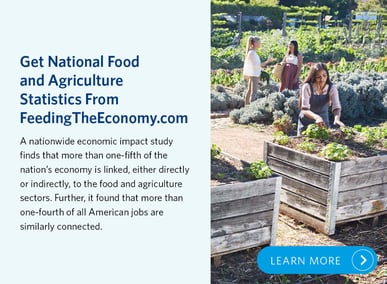-
9 Strategies to Showcase Dairy's Economic Impact in Your State
By USDEC March 14, 2019- Tweet
Dairy supports nearly 3 million U.S. jobs and a new study shows more than 45 million jobs are connected to the food and agriculture sectors.
When three Washington-based dairy organizations joined forces last year to tell dairy's economic impact story, we agreed on a unified message: "Dairy creates jobs, exports create more."
That was a start, but a huge challenge remained.
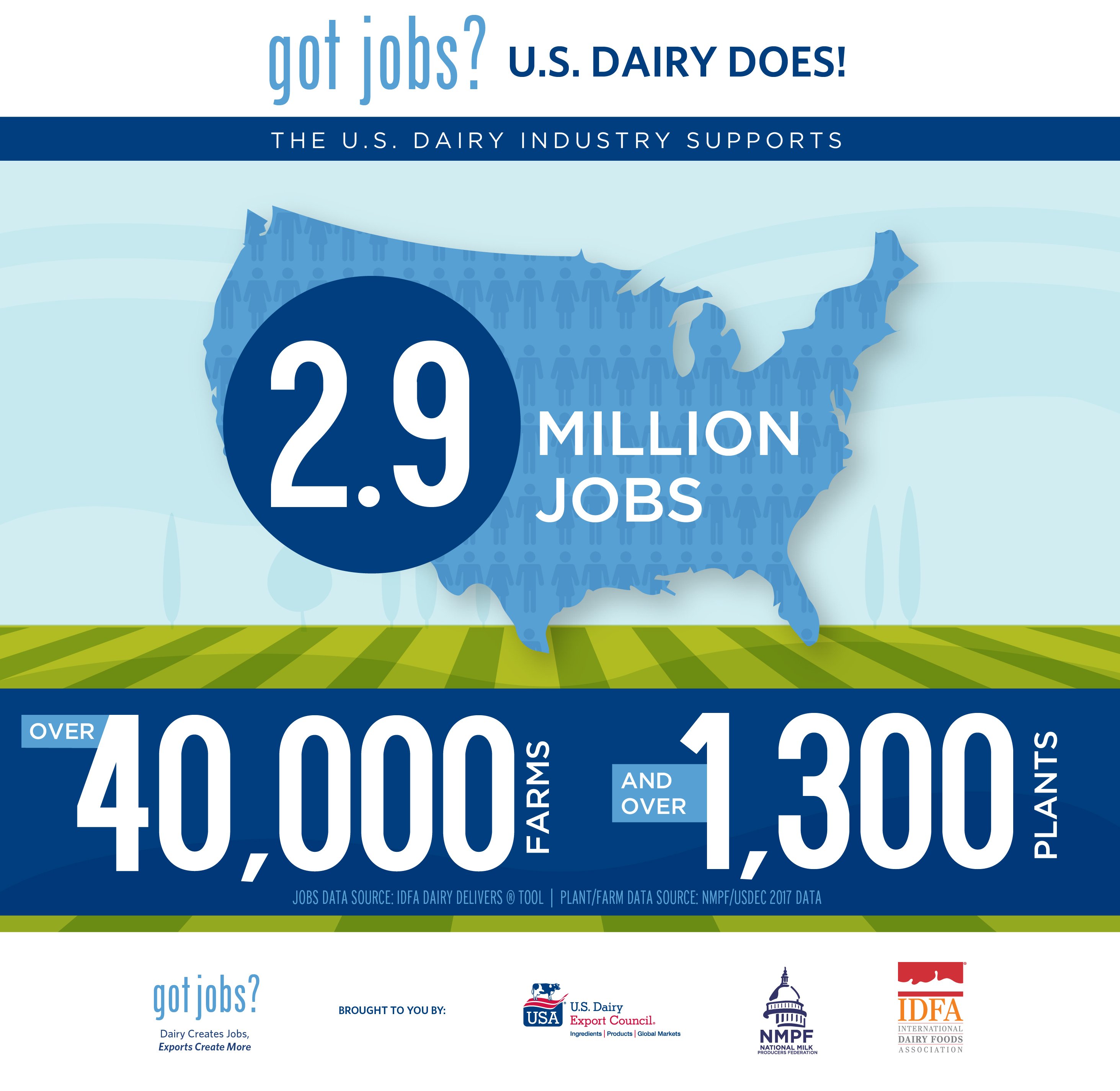
How could we deliver that educational message so it resonated in a swirling sea of conflicting economic claims made by academics, think tanks, industry groups and others?
Solution: We divided and conquered and found strength in numbers.
Those numbers included research-based economic data and amplification of content by dairy organizations across the country.
Amazingly, the campaign accomplished all of its quantifiable goals in just five months, seven months ahead of schedule. Key performance indicators as of March 2019 include:
- More than 1,900 social media mentions and 483 news articles of "dairy" appearing within five words of "jobs," according to monitoring by Meltwater News.
- Nearly 400 pieces of content ranging from fact sheets to videos created by the three sponsoring organizations.
- More than 50 dairy groups beyond Washington utilizing these resources to tell dairy's economic impact story in their states and local communities.
Stories -- backed by data
The dairy industry has always had compelling stories to tell about hard-working producers, processors and others in a supply chain that starts on the farm and can end up with exports of cheese and other dairy products to faraway places like Southeast Asia hungry for what U.S. Dairy offers.
What made this effort particularly effective was data sliced and diced into accessible economic fact sheets, infographics, photos and videos at GotDairyJobs.org, a portal created and managed by the U.S. Dairy Export Council, the National Milk Producers Federation and the International Dairy Foods Association.
IDFA's economic impact tool, Dairy Delivers®, is a significant research project that quantifies our industry's economic ripple effect. Most important for dairy state and regional organizations is the ability to drill down for granular data on economic outputs like wages, tax revenue and GDP for every state and congressional district.
Clearinghouse of reliable info
GotDairyJobs.org has turned into a clearinghouse of information educating consumers, taxpayers and the U.S. public about the dairy industry's economic impact.
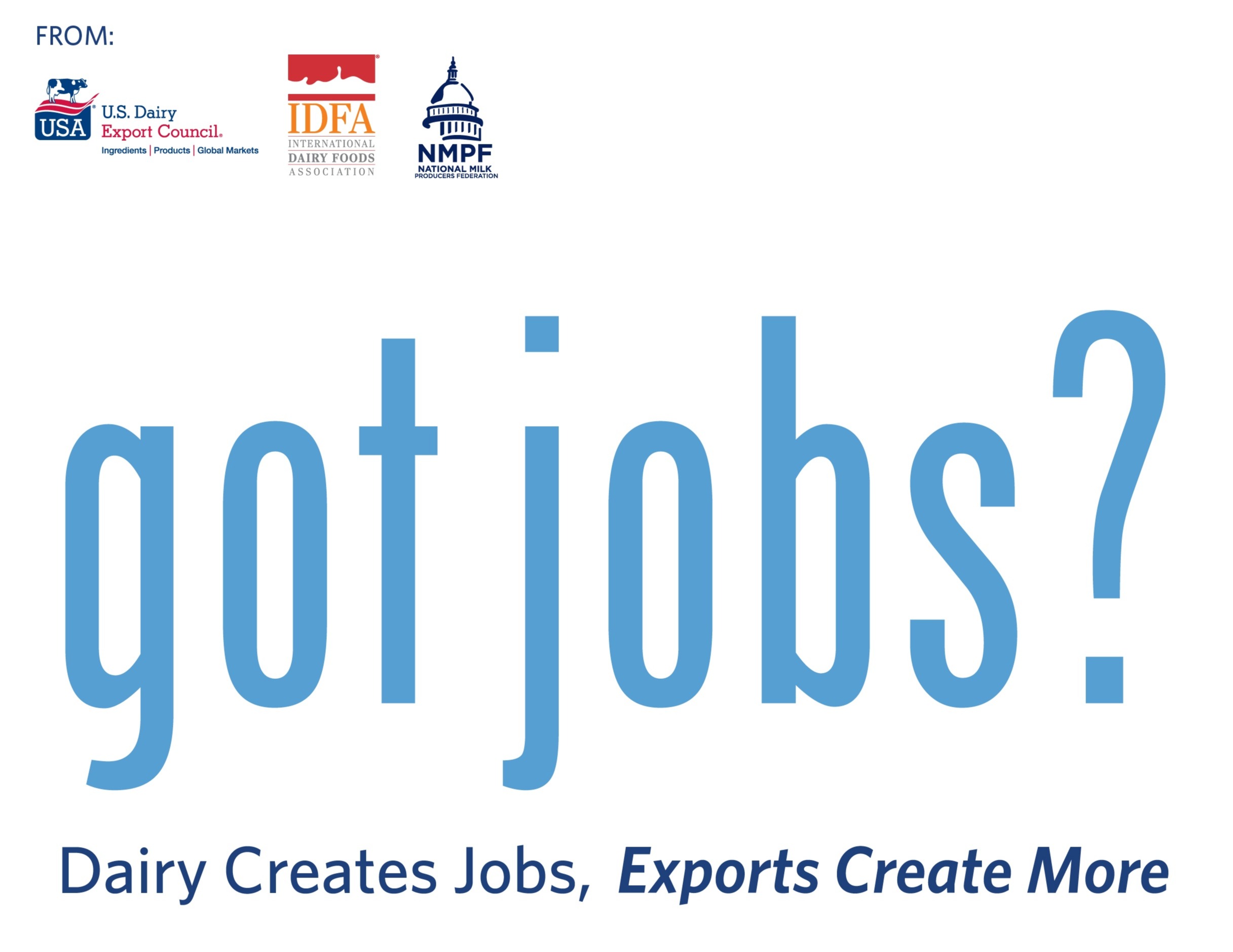
In an article, "How Three Associations Partnered to Tame the Content Beast," Associations Now magazine praised the campaign as a prototype for other organizations want to collaborate.
Even more gratifying for USDEC, NMPF and IDFA are increasing reports from dairy organizations across the country that they are utilizing these resources at the state and local level.
"When people see how many jobs the dairy industry contributes to their local communities, it really speaks to them,” says Carol Hardbarger, consumer member of the Pennsylvania Milk Marketing Board. "Anyone with a job, whether in agriculture or not, can relate to this. Everyone wants those jobs to remain in the state—and even grow in number."
How can you use data to showcase dairy's economic impact in your state? Here are nine effective strategies we have seen:
1. Distribute one-page state fact sheets.
The Pennsylvania Milk Marketing Board's Carol Hardbarger is a tireless advocate for the dairy industry.
Hardbarger has found the one-page state fact sheets downloadable from GotDairyJobs.org invaluable for:
- Listening sessions between PMMB and dairy farmers in the state.
- PMMB’s newsletter that goes to milk processors, dairy farmers, state legislators, staff members in the state department of agriculture, ag lobbying organizations, county extension offices and others.
- A list-serve email that includes the state secretary of agriculture and staff members on state Senate and House Ag and Rural Affairs Committees.
Government officials in Minnesota picked up fact sheets displayed at a recent ice cream social hosted by Midwest Dairy at the State Capitol.
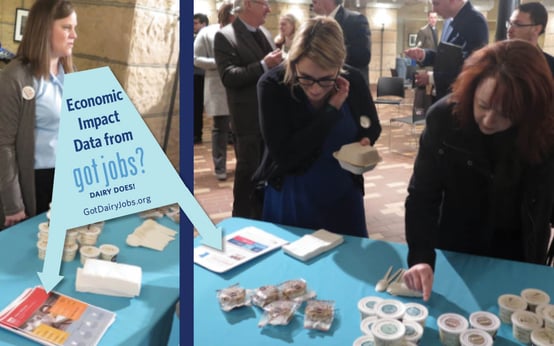 Dairy farmer Mary Arendt, shown at left, staffed a table at the Minnesota State Capitol, offering ice cream and state fact sheets. One of the fact sheets explained the impact of dairy on the Minnesota economy, while another described the economic benefit of dairy exports from the Gopher State. Looking over the offerings, at right, are Minnesota Lt. Governor Peggy Flanagan and State Auditor Julie Blaha.
Dairy farmer Mary Arendt, shown at left, staffed a table at the Minnesota State Capitol, offering ice cream and state fact sheets. One of the fact sheets explained the impact of dairy on the Minnesota economy, while another described the economic benefit of dairy exports from the Gopher State. Looking over the offerings, at right, are Minnesota Lt. Governor Peggy Flanagan and State Auditor Julie Blaha.
How do you get these fact sheets? At gotdairyjobs.org, you can download a "state bundle" of three fact sheets providing:
- A visually appealing overview with three data points about your state.
- A breakdown of key economic indicators in your state.
- An explanation of "dairy exports by the numbers" in your state.
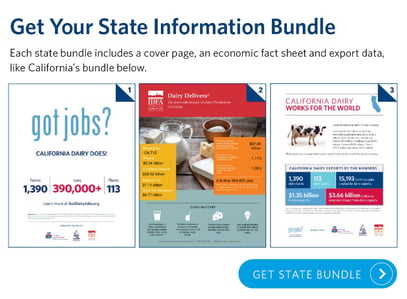
2. Create your own infographic.
The American Dairy Association Mideast, an affiliate of The National Dairy Council, created this graphic published in a Columbus, Ohio, business publication.
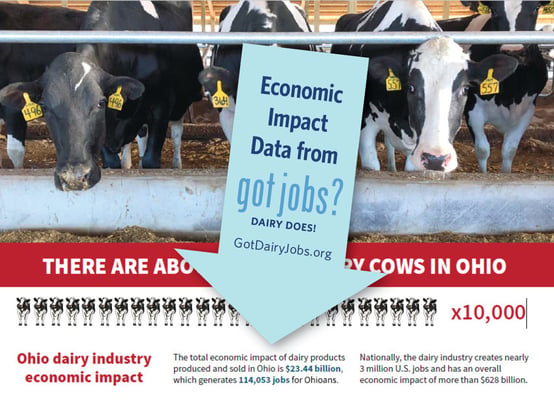
“The `Got Jobs?' information was perfect to share with our business leaders," said Jenny Hubble, senior vice president of communications at American Dairy Association Mideast. "We appreciate having it as a resource,”
Barb Williams, dairy processing specialist with Cornell Cooperative Extension, shared "Got Jobs?" data with colleagues who developed the infographics below and shared with state legislators.
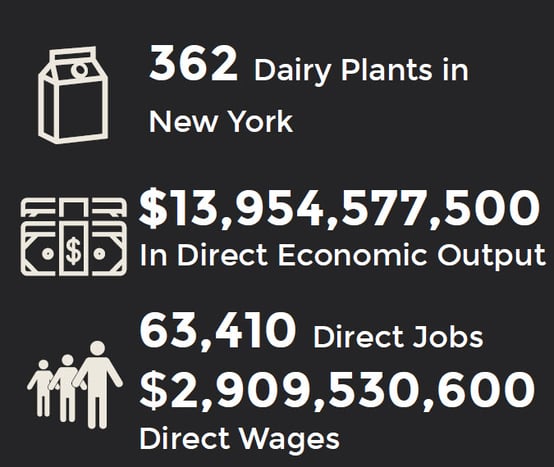
“Due to the fact New York State funds some extension programs directly, it is important for legislators to understand the impact of these (dairy-related) jobs on the local economy,” Williams said.
Similarly, the Iowa State Dairy Association (ISDA) included economic impact data in a document handed out to state legislators on March 12.
Associate Director Jenna Finch said that when ISDA communicates with policymakers, "we really hone in on the economic impact numbers and the number of jobs."
A national trade publication, Dairy Herd Management, published this eye-catching infographic with "Got Jobs?" data.
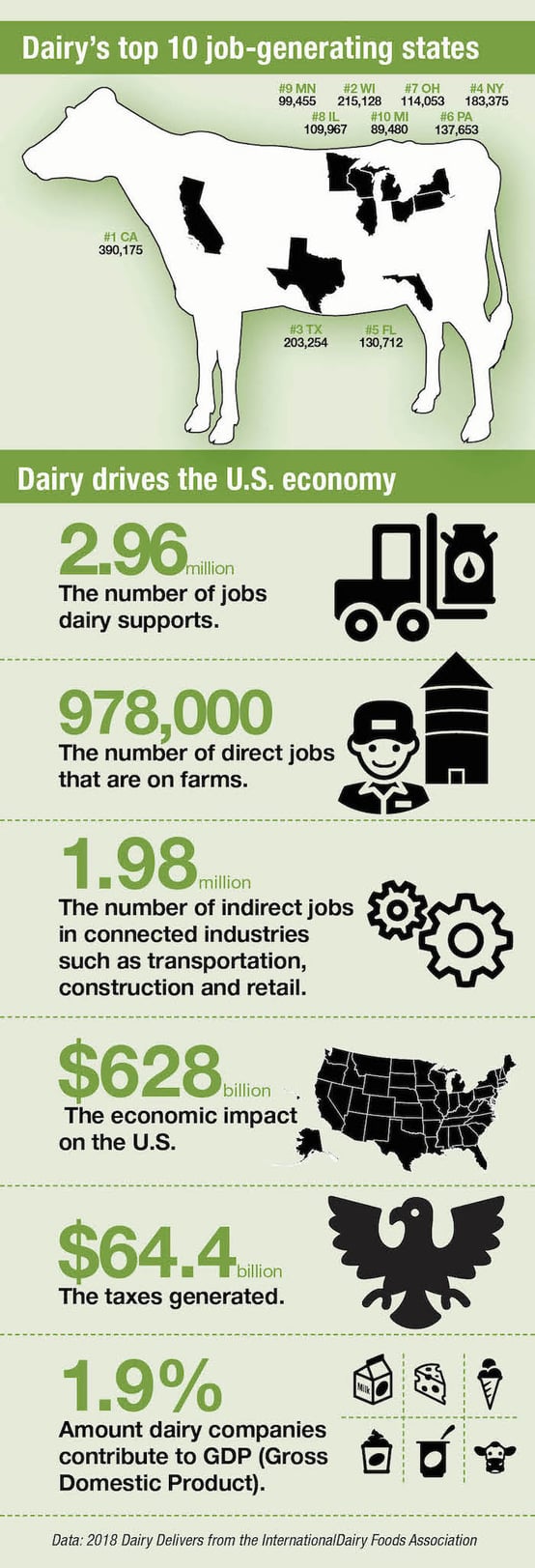
3. Connect dairy to agriculture's job-creation story.
Putting dairy's economic impact into a broader context makes for an even better, more textured, story.
On Wednesday, a nationwide economic impact study was released that gives dairy organizations new ability to do just that. The study found that more than one-fifth of the nation’s economy is linked, either directly or indirectly, to the food and agriculture sectors.

More than 45 million jobs, one-fourth of all American jobs, are similarly connected.
The research is available at www.FeedingTheEconomy.com.
4. Embed, play and share videos.
Videos for the top 10 dairy jobs-generating states—California, Wisconsin, New York, Texas, Florida, Pennsylvania, Ohio, Minnesota, Illinois and Michigan—are available at the Got Dairy Jobs site.
A video is also available showing dairy's national economic impact.
Videos can be played at meetings, embedded into websites and shared by email.
5. Amplify, amplify, amplify on social media.
A smart social media strategy is how "Got Jobs?" has flown "under the radar" to make an impact with no advertising budget.
Many but not all of the 1,900 social media posts to date originated with NMPF, IDFA and USDEC, all using the #GotDairyJobs hashtag for easy tagging and tracking. Amplification occurs when people "like," "retweet" and "share" what they see with people in their respective social media tribes, who in turn share it with their networks.
The end result is a mushrooming effect.
For example, Sheri Allen, a certified cheese professional from West Point, Utah, retweeted the following post from USDEC to her followers. “I’m happy to spread the word!” she says.
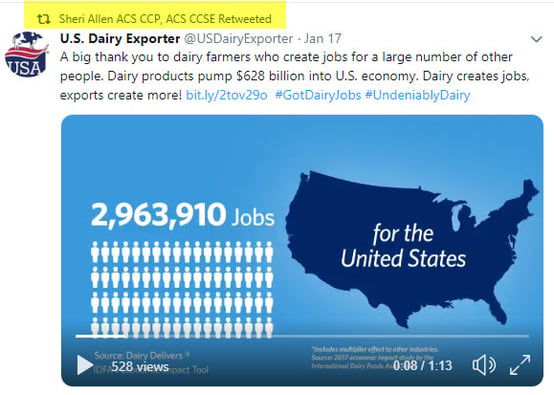
Another amplifier is Theresa Sweeney, special projects coordinator at the New York State Department of Agriculture and Markets.“Dairy is obviously a priority for our Department, as it accounts for 50 percent of agriculture in our state (by sales). We promote dairy farms and/or processors on our social media platforms at least every other week,” Sweeney says.
6. Weave data into websites and newsletters.
Last May, Stephanie Cundith, of the Midwest Dairy corporate communications team, wrote a 520-word article that appeared in the organization's electronic newsletter.
.jpg?width=554&name=Got%20Jobs%20sharing21%20(3).jpg)
Scott Higgins, CEO of the American Dairy Association Mideast, wrote this article that appears on the Association's website.
7. Offer the research to hungry journalists.
Journalists are constantly looking for ways to provide local examples of national trends. Your state economic impact resources are a gold mine for media.
Let them know by calling, emailing or communicating via social media, always providing an easy link to the resources.
Through a partnership between American Dairy Association Mideast and Columbus Business First, this article appeared in the Cincinnati Business Courier:
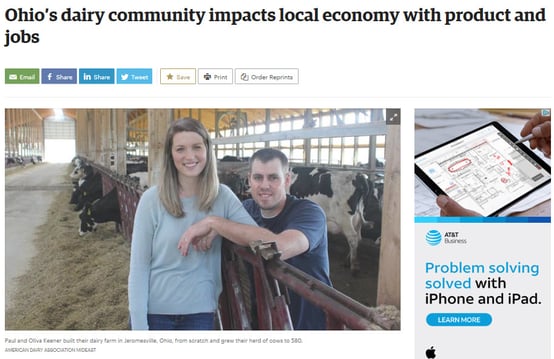
8. Write guest editorials and letters to the editor.
The U.S. Dairy Export Council offered this opinion piece by President and CEO Tom Vilsack to The Sacramento Bee newspaper. The article quantified the importance of dairy to California’s economy and explained how free-trade agreements support jobs in California by giving exporters a level playing field to compete with global competitors.
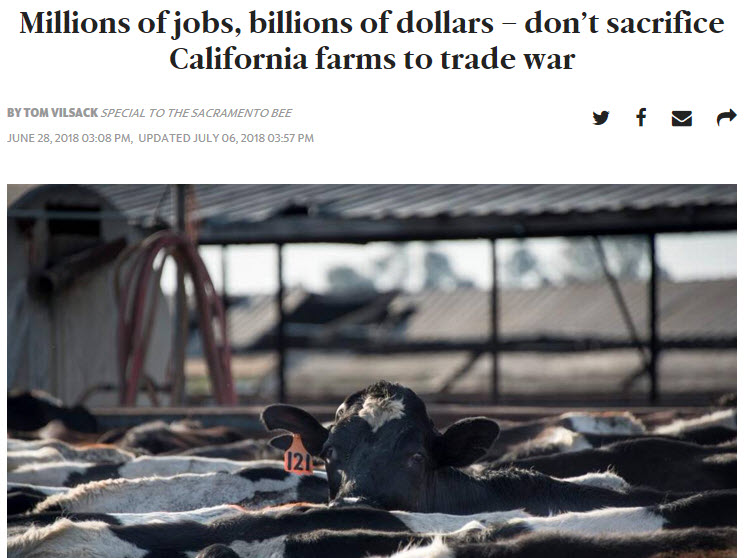
While placing an op-ed can be difficult getting a letter to the editor published is easier, especially if you make a point backed up by data.
9. Show faces of real people working real jobs, thanks to dairy.
Karianne Fallow, CEO of Dairy West, used photos and video to put a "face" on families—and jobs—in this article showing the Teunissen family from Caldwell, Idaho.
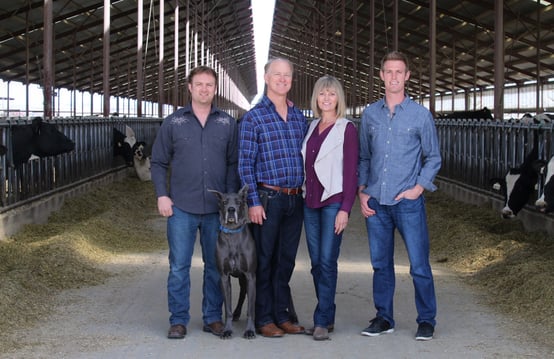
The article points out that more than 95 percent of American dairy farms are family-owned businesses, not Fortune 500 corporations. What’s more, unlike many industries, dairy is decentralized, boosting the economies of every rural community, city and state.
Showing real people working real dairy jobs connects dairy faces to our data points. It's memorable local, state and regional storytelling like this that drives home our industry's unified message: "Dairy creates jobs, exports create more."
Mark O'Keefe is vice president of editorial services at the U.S. Dairy Export Council. He helps manage the ongoing "Got Jobs?" campaign. Have you tapped into the "Got Jobs?" resources? Let Mark know at mokeefe@usdec.org.
Learn more about dairy's economic impact story:
- GotDairyJobs.org clearinghouse of information
- FeedingTheEconomy.com research quantifying food and agriculture sector's economic impact
- Data: Dairy's Positive Impact on U.S. Economy
- 10 New State Videos Show Dairy's Impact on Jobs
- VIDEOS and MORE: Dairy's Amazing 'Jobs Machine'
- DATA: California is U.S. Dairy's Biggest Jobs Machine
- PROFILES: Economic Ripple Effect of Dairy Begins with the Farmer
- ANALYSIS: Thank Dairy for $64 Billion in Tax Revenue
- INFO BUNDLES: How Dairy Creates Jobs and Tax Revenue in Your State
- NEVADA: Dairy Exports Revive Farmer's Dream
Subscribe to the U.S. Dairy Exporter Blog
The U.S. Dairy Export Council fosters collaborative industry partnerships with processors, trading companies and others to enhance global demand for U.S. dairy products and ingredients. USDEC is primarily supported by Dairy Management Inc. through the dairy farmer checkoff. How to republish this post.
10 Most Recent Posts
Most Popular Posts in Past Year
Index of Posts by Topic
- #GotDairyJobs (4)
- About USDEC (66)
- Africa (6)
- Australia (4)
- Blog (8)
- Brazil (4)
- Canada (20)
- Central America (1)
- Cheese (58)
- Chile (1)
- China (54)
- Common food names (7)
- Company News (20)
- Consistent Supply (1)
- Crisis Management (3)
- Cuba (2)
- Dairy (6)
- Dairy checkoff (9)
- Dairy Ingredients (5)
- Dairy Management Inc. (2)
- Dairy Resources (1)
- Dairy Supply Chain (1)
- Dairy Trends (5)
- Documentation (3)
- EU (24)
- Experts on Dairy Exports (4)
- Exporter of the Year (2)
- Exports (24)
- Farmer leaders (1)
- Farming (38)
- Food Aid (8)
- Food Safety (8)
- Foodservice (3)
- Free trade agreements (34)
- Future trends (1)
- Geographical Indications (GIs) (10)
- Global Marketing (86)
- Global Shipping Crisis (1)
- Got Jobs? (9)
- Indonesia (1)
- Innovation (17)
- Japan (17)
- Krysta Harden (1)
- Market Access (25)
- Market Conditions (268)
- Member Services (17)
- Mexico (41)
- Middle East (9)
- Middle East & North Africa (3)
- Middle East/North Africa (9)
- Milk (4)
- Milk Protein Concentrate (MPC) (2)
- New Zealand (11)
- Next5% (20)
- Nonfat Dry Milk/Skim Milk Powder (8)
- Nutrition (19)
- Product Innovation (6)
- Protein (4)
- Regulations (5)
- Research & Data (326)
- Russia (3)
- Singapore (10)
- South America (8)
- South Korea (10)
- Southeast Asia (25)
- Strategic Insights (1)
- Supply (1)
- Sustainability (26)
- Technology (2)
- ThinkUSADairy (5)
- TPM23 (1)
- TPP (13)
- Traceability (8)
- Trade Barriers (5)
- Trade Data (7)
- Trade Policy (72)
- TTIP (5)
- UHT Milk (7)
- USMCA (2)
- Vietnam (4)
- Whey (6)
- Whey Ingredients (2)
- Whey products (10)
- Whole Milk Powder (WMP) (3)
- World Dairy Expo (1)
- World Milk Day (1)
- Yogurt (1)
Index of Posts by Date, Author
- June 2021 (13)
- March 2015 (12)
- September 2015 (12)
- April 2015 (11)
- December 2015 (11)
- March 2014 (10)
- February 2015 (10)
- October 2015 (10)
- October 2014 (9)
- June 2015 (9)
- July 2015 (9)
- November 2015 (9)
- March 2016 (9)
- October 2019 (9)
- September 2013 (8)
- May 2015 (8)
- August 2015 (8)
- January 2016 (8)
- February 2016 (8)
- March 2017 (8)
- December 2018 (8)
- May 2019 (8)
- December 2019 (8)
- June 2014 (7)
- November 2016 (7)
- May 2017 (7)
- May 2018 (7)
- July 2020 (7)
- June 2023 (7)
- July 2016 (6)
- August 2018 (6)
- October 2018 (6)
- November 2018 (6)
- February 2019 (6)
- June 2019 (6)
- August 2019 (6)
- March 2020 (6)
- April 2020 (6)
- June 2020 (6)
- June 2022 (6)
- February 2014 (5)
- June 2016 (5)
- August 2016 (5)
- September 2016 (5)
- December 2016 (5)
- February 2017 (5)
- July 2017 (5)
- October 2017 (5)
- January 2018 (5)
- April 2018 (5)
- June 2018 (5)
- July 2018 (5)
- September 2018 (5)
- January 2019 (5)
- March 2019 (5)
- April 2019 (5)
- July 2019 (5)
- September 2019 (5)
- November 2019 (5)
- January 2020 (5)
- August 2020 (5)
- October 2020 (5)
- April 2021 (5)
- January 2022 (5)
- May 2013 (4)
- September 2014 (4)
- April 2016 (4)
- May 2016 (4)
- October 2016 (4)
- January 2017 (4)
- April 2017 (4)
- June 2017 (4)
- August 2017 (4)
- September 2017 (4)
- December 2017 (4)
- February 2018 (4)
- February 2020 (4)
- May 2020 (4)
- February 2022 (4)
- September 2022 (4)
- April 2023 (4)
- December 2023 (4)
- November 2017 (3)
- March 2018 (3)
- September 2020 (3)
- December 2020 (3)
- February 2021 (3)
- May 2021 (3)
- August 2021 (3)
- December 2021 (3)
- March 2022 (3)
- April 2022 (3)
- May 2022 (3)
- October 2022 (3)
- December 2022 (3)
- May 2023 (3)
- July 2023 (3)
- November 2023 (3)
- March 2011 (2)
- June 2011 (2)
- September 2011 (2)
- March 2012 (2)
- June 2012 (2)
- July 2012 (2)
- March 2013 (2)
- July 2013 (2)
- November 2020 (2)
- January 2021 (2)
- March 2021 (2)
- July 2021 (2)
- September 2021 (2)
- October 2021 (2)
- November 2021 (2)
- July 2022 (2)
- August 2022 (2)
- January 2023 (2)
- March 2023 (2)
- October 2023 (2)
- January 2024 (2)
- February 2024 (2)
- April 2024 (2)
- June 2024 (2)
- July 2024 (2)
- November 2024 (2)
- December 2024 (2)
- February 2025 (2)
- June 2025 (2)
- July 2025 (2)
- September 2025 (2)
- November 2025 (2)
- December 2025 (2)
- January 2010 (1)
- February 2010 (1)
- March 2010 (1)
- April 2010 (1)
- May 2010 (1)
- June 2010 (1)
- July 2010 (1)
- August 2010 (1)
- September 2010 (1)
- October 2010 (1)
- November 2010 (1)
- December 2010 (1)
- January 2011 (1)
- February 2011 (1)
- April 2011 (1)
- May 2011 (1)
- July 2011 (1)
- August 2011 (1)
- October 2011 (1)
- November 2011 (1)
- December 2011 (1)
- January 2012 (1)
- February 2012 (1)
- April 2012 (1)
- August 2012 (1)
- September 2012 (1)
- October 2012 (1)
- November 2012 (1)
- December 2012 (1)
- January 2013 (1)
- February 2013 (1)
- April 2013 (1)
- June 2013 (1)
- August 2013 (1)
- October 2013 (1)
- November 2013 (1)
- December 2013 (1)
- January 2014 (1)
- April 2014 (1)
- May 2014 (1)
- November 2022 (1)
- February 2023 (1)
- August 2023 (1)
- September 2023 (1)
- March 2024 (1)
- May 2024 (1)
- August 2024 (1)
- September 2024 (1)
- October 2024 (1)
- January 2025 (1)
- March 2025 (1)
- April 2025 (1)
- May 2025 (1)
- August 2025 (1)
- USDEC (183)
- USDEC Staff (164)
- Alan Levitt (119)
- Tom Suber (41)
- Margaret Speich (22)
- Marc A.H. Beck (15)
- Vikki Nicholson-West (11)
- Angélique Hollister (11)
- Tom Vilsack (8)
- Jaime Castaneda (7)
- Matt McKnight (7)
- Véronique Lagrange (7)
- Margaret Speich and Mark O'Keefe (7)
- Ross Christieson (7)
- Paul Rogers (6)
- Shawna Morris (5)
- William Loux (5)
- Alan Levitt and Marc Beck (5)
- Krysta Harden (4)
- USDEC Communications (3)
- Kristi Saitama (3)
- Marilyn Hershey (3)
- Brad Gehrke (3)
- Tom Quaife (2)
- Nick Gardner (2)
- Jim Mulhern (2)
- Alan Levitt and William Loux (2)
- Kara McDonald (2)
- Luke Waring (2)
- Merle McNeil (2)
- Andrei Mikhalevsky (1)
- Rodrigo Fernandez (1)
- Dermot Carey (1)
- Jeremy Travis (1)
- Annie Bienvenue (1)
- Ross Christieson and Shawna Morris (1)
- Becky Nyman (1)
- Paul Rogers and Tom Quaife (1)
- Rick Ortman (1)
- Tony Rice (1)
- Barbara O’Brien (1)
- Paul Rogers and Mark O'Keefe (1)
- Dalilah Ghazalay (1)
- Amy Wagner (1)
- Mitchell Bowling (1)
- Erica Louder (1)
- Brad Scott (1)
- Amy Foor (1)
- Scott Lantz (1)
- Sandra Benson (1)
- Errico Auricchio (1)
- Jaclyn Krymowski (1)
- Krysta Harden, USDEC President and CEO (1)
.png)

